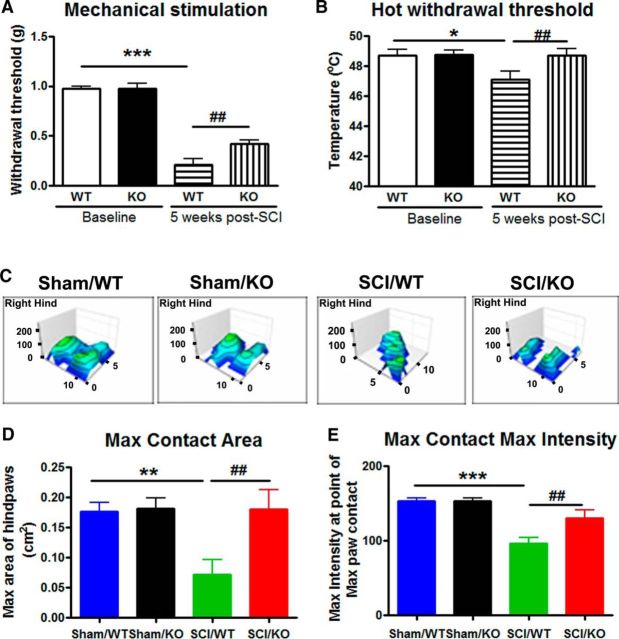Figure 10.
Behaviors indicative of neuropathic pain were reduced in T1-GFAP KO mice compared with WT mice at the chronic phase of injury. A, Mechanical allodynia as tested using von Frey filaments was detected in mice at 5 weeks after SCI, but was found to be less severe in T1-GFAP KO mice than in WT mice. B, Thermal hyperalgesia recovered to near-baseline levels in KO mice, in contrast to heightened sensitization in WT mice. N = 8–9 mice/group. *p < 0.05, ***p < 0.001 versus Baseline; ##p < 0.01 versus SCI/WT (2-way ANOVA with Student's Newman–Keuls post hoc analysis). C–E, TrkB.T1-GFAP KO mice showed significant improvements in spontaneous pain-like behaviors in the CatWalk compared with WT mice. Sample images of paw impressions in the CatWalk, depicting both total area of the step and magnitude of impression are indicated in C. Maximum contact area was automatically calculated as the total area of the hindpaw at the point of maximum placement, as shown by the X and Z axes of the paw print map. Maximum intensity at maximum contact used the same paw print as that of maximum contact area, but explored the highest point of intensity, or the y-axis on the paw print map, with greater intensities appearing on a scale of blue to green where green is high intensity. Higher intensities on the maximum intensity at maximum contact are indicative of increased weight-bearing on the hindpaws, further suggesting a reduction in spontaneous allodynic pain. N = 5–6 mice/group. **p < 0.01, ***p < 0.001 versus Sham/WT; ##p < 0.01 versus SCI/WT (2-way ANOVA with Student's Newman–Keuls post hoc analysis).

